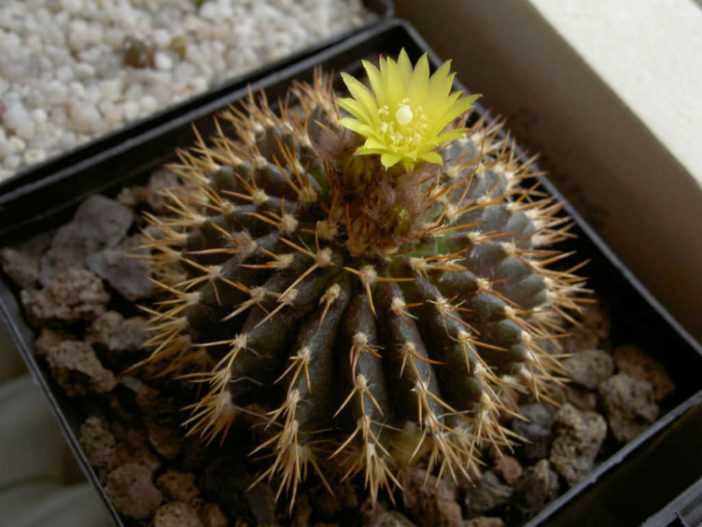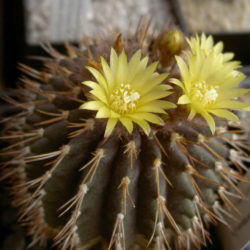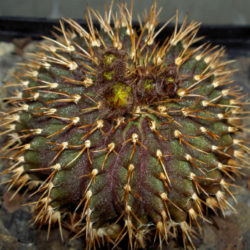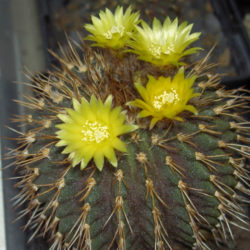Scientific Name
Uebelmannia buiningii Donald
Scientific Classification
Family: Cactaceae
Subfamily: Cactoideae
Tribe: Cereeae
Genus: Uebelmannia
Origin
Uebelmannia buiningii is native to southeastern Brazil. It grows on quartz grit in Minas Gerais.
Description
Uebelmannia buiningii is a small cactus with a spherical to short cylindrical stem with 18 ribs lined with tubercles, each with a wooly areole that bears a cluster of spines. The stem can grow up to 3.2 inches (8 cm) in diameter. They are greenish to reddish-brown and rough due to wax deposits. The ribs are spaced up to 0.6 inches (1.5 cm) apart. Each areole bears 4 central and 2 to 4 radial spines. The radial spines are up to 0.2 inches (0.5 cm) long, while the central spines are longer and crossed.
The yellow flowers are funnel-shaped and can reach up to 1.1 inches (2.7 cm) long and 0.8 inches (2 cm) in diameter. They appear at the top of the stems from early summer to late summer. The fruits are yellow, egg-shaped, and can reach up to 0.15 inches (0.4 cm) in diameter.

Hardiness
USDA hardiness zones 10a to 11b: from 30 °F (−1.1 °C) to 50 °F (+10 °C).
How to Grow and Care
Even for cacti, these plants have a low tolerance for cold temperatures, and letting them into even temperate conditions is an easy way to damage them. Make sure to keep well-watered, as well, and give them lots of light.
Their roots need some space and good drainage and keep an eye out for common pests that can damage them. Uebelmannias are such rare and difficult plants that only those with lots of practice growing cacti will likely even have access to them. These will likely only be found in specialty shops, and their cultivation should be left to the experts. If you cultivate one, they are among the most singular-looking of all cacti.
If free-standing in their pots, Uebelmannias can be repotted at the beginning of each growing season by lifting the plant out as a whole and replacing it in a larger container, making sure to spread the roots out in the new soil. Don't pack them in too tightly, as this can damage their root systems and make it hard to retain water.
See more at How to Grow and Care for Uebelmannia.
Links
- Back to genus Uebelmannia
- Succupedia: Browse succulents by Scientific Name, Common Name, Genus, Family, USDA Hardiness Zone, Origin, or cacti by Genus
Photo Gallery
Click on a photo to see a larger version.


